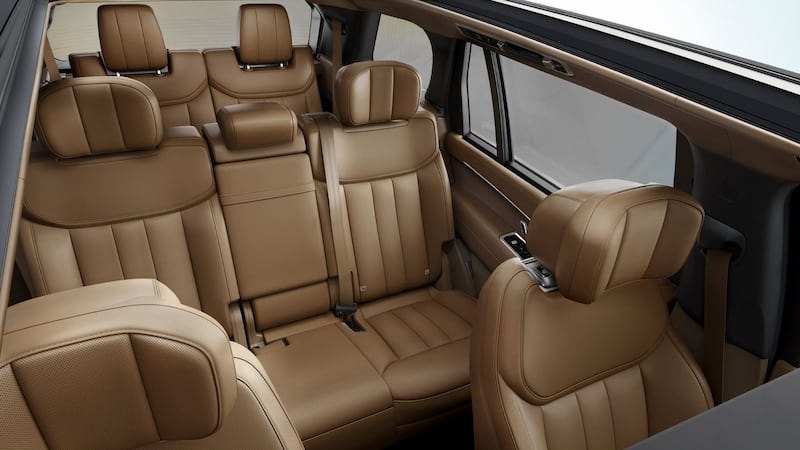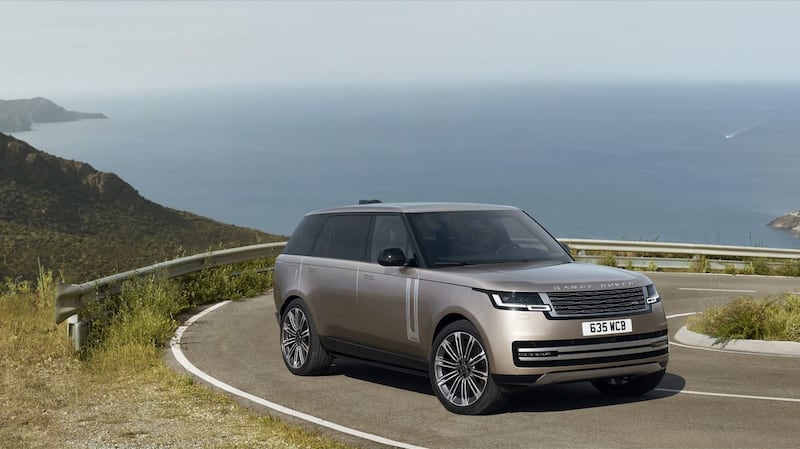The all-new Range Rover certainly doesn't look all-new. In fact, aside from rear end styling that has been pared back to the barest minimum of lines and lights, it would be incredibly easy to mistake it for the current, outgoing model.
Under the skin, though, the new Range Rover is indeed both new and - in theory - improved relative to its predecessor, not least in its electrified powertrain offerings.
However, the styling is very, very evolutionary, drawing heavily on the outgoing Range Rover and the smaller Velar, both cars overseen by the man in charge of design for both Land Rover and Jaguar, Gerry McGovern. You can adjust your own personal level of irony to account for the fact that a man from a working class family in Birmingham, with familial links to Leitrim, is in charge of making sure that the most upper-crust of all off-roaders looks right.
“The New Range Rover is a vehicle with a peerless character, from the impeccable restraint of its exterior to the flawless tranquil sanctuary of its cabin. Informed by creative intellect and a desire for perfection, it doesn’t follow fashion or trend, but by a modernist design philosophy, combined with over 50 years of evolution, it is quite simply the most desirable Range Rover ever created” said McGovern at the car’s reveal.
Inside, the same pared-back design philosophy applies, with many of the major controls - alas - having migrated from physical buttons to on-screen apps.

Massive screen
There’s a massive 13-inch, curved screen in the centre of the dash, with thankfully still partially physical click-wheel controllers below for keeping an eye on the car’s air conditioning and heating.
That screen is running the latest version of Land Rover's 'Pivi Pro' software, an infotainment system that has vaulted Land Rover's electronics suite from also-ran to tightly competitive with its German peers. Will it be good enough for the regal Range Rover? We shall see. It will come with built-in Amazon Alexa, and over-the-air software updates.
Certainly, it will be all-but silent in the cabin. There are 35 speakers for the Meridian sound system inside, including individual 20-watt speakers built into each seat’s headrest.

This stereo doesn’t only play music, or provide access to the inside of Joe Duffy’s mind - it’s also a vast noise-cancelling system, playing an ‘opposing frequency’ to blot out unwanted wind rush and tyre roar. Such systems can be very hit-or-miss in rival models, so let’s wait and see just how selpulchral the Range Rover’s inside really is.
Allergens and viruses
It will be clean in there, though - the latest Cabin Air Purification Pro system is fitted, which filters out allergens, pollen, and unwanted nasties from the air coming into the car. Yes, even Covid. Land Rover claims that the system is: "scientifically proven to significantly reduce viruses and bacteria including SARS-CoV-2 viruses."
The rear seats can be configured in either a three-seat or a more luxurious two-seat layout, and with either a standard or a long-wheelbase. For the first time ever in the ‘full-size’ Range Rover, there will be the option of extra folding seats in the boot. Rear seat passengers can optionally have their own 11-inch screens mounted to the back of the front headrests, and another tablet-like controller in the rear armrest.
For the moment, the power for all of this mobile luxury comes from familiar sources - Land Rover's existing range of mild-hybrid petrol and diesel straight-six engines will be more or less carried over, but there is a new top-spec V8 twin-turbo engine, bought in from BMW, that is claimed to offer a 17 per cent improvement in economy and emissions compared with the old supercharged V8 (which dates back to a mid-nineties Jaguar design).
Of rather more import are the upgraded plugin-hybrid models. There are two - P440e and P510, the badges denoting the combined power output in hp of the turbo straight-six petrol engines and their electric motors.
Electric advances
The electric system has been significantly upgraded, to compete with the latest PHEVs from Mercedes, with 100km WLTP ranges (claimed, not yet confirmed) on a full charge of the massive 31.8kWh (useable) battery. Land Rover claims 5.7secs from 0-100km/h, yet Co2 emissions of less than 30g/km - and that 75 per cent of an average Range Rover owner’s driving can be carried out on electric power alone. Doubtless, your average Range Rover owner will not be bothered by the loss of the €2,500 SEAI grant.
That electric mileage figure will rise to 100 per cent come 2024 - the Range Rover is the first to use Land Rover's new MLA-Flex (nothing to do with the malleability of Belfast politicians…) platform which has been designed for combustion, hybrid, and fully-electric power. The first all-electric Range Rover (the first all-electric Land Rover, come to that) will launch in 2024, although Land Rover is unsurprisingly reticent about providing any technical details as yet.
The balance between on-road comfort and off-road ability will be handled by an air suspension system with active anti-roll bars, which - electrically actuated by the 48-volt mild-hybrid system - can press down on the springs with a force of 1,400Nm to keep the Range Rover’s body steady in the bends.
That the new Range Rover will be critical to Jaguar Land Rover's future is unquestionable. It has the difficult task of maintaining the model's top-notch image amid increasing competition from Germany, Japan, and Tesla. It also has to generate enough profits to help pay for JLR's commitment to only launch fully-electric models from 2026 onwards, and to shore up the company's oft-rocky finances in the meantime. No easy task, even for one so majestic as this.
Thierry Bolloré, Jaguar Land Rover’s chief executive, said: “The New Range Rover is a superb manifestation of our vision to create the world’s most desirable luxury vehicles, for the most discerning of customers. It writes the next chapter in the unique story of pioneering innovation that has been a Range Rover hallmark for more than 50 years.”
















